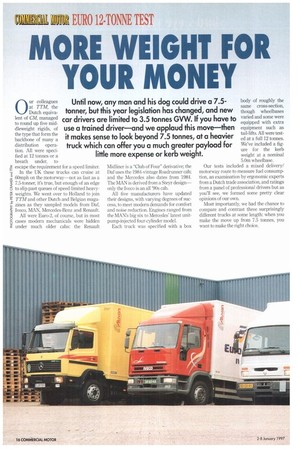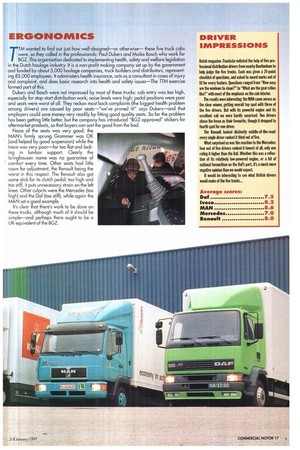MORE WEIGHT FOR YOUR MONEY
Page 18

Page 19

If you've noticed an error in this article please click here to report it so we can fix it.
Until now, any man and his dog could drive a 7.5tonner, but this year legislation has changed, and new car drivers are limited to 3.5 tonnes GVW. If you have to use a trained driver—and we applaud this move—then it makes sense to look beyond 7.5 tonnes, at a heavier truck which can offer you a much greater payload for little more expense or kerb weight.
0 ur colleagues at 77M, the Dutch equivalent of CM, managed to round up five middleweight rigids, of the type that form the backbone of many a distribution operation. All were specified at 12 tonnes or a breath under, to I escape the requirement for a speed limiter.
, In the UK these trucks can cruise at 60mph on the motorway—not as fast as a 7.5-tonner, it's true, but enough of an edge o to slip past queues of speed-limited heavyweights. We went over to Holland to join e7'7'M and other Dutch and Belgian maga zines as they sampled models from Daf, i Iveco, MAN, Mercedes-Benz and Renault.
8 All were Euro-2, of course, but in most 6 cases modern mechanicals were hidden E. under much older cabs: the Renault Midliner is a "Club of Four" derivative; the Daf uses the 1984-vintage Roadrunner cab; and the Mercedes also dates from 1984. The MAN is derived from a Steyr design— only the Iveco is an all '90s cab.
All five manufacturers have updated their designs, with varying degrees of success, to meet modern demands for comfort and noise reduction. Engines ranged from the MAN's big six to Mercedes' latest unitpump-injected four-cylinder model.
Each truck was specified with a box body of roughly the same cross-section, though wheelbases varied and some were equipped with extra equipment such as tail-lifts. All were tested at a full 12 tonnes. We've included a figure for the kerb weight at a nominal 5.0m wheelbase.
Our tests included a mixed delivery/ motorway route to measure fuel consumption, an examination by ergonomic experts from a Dutch trade association, and ratings from a panel of professional drivers but as you'll see, we formed some pretty clear opinions of our own.
Most importantly, we had the chance to compare and contrast these surprisingly different trucks at some length: when you make the move up from 7.5 tonnes, you want to make the right choice. TTM wanted to find out just how well-designed—or otherwise— these five truck cabs were, so they called in the professionals: Paul Dukers and Maike Bosch who work for BGZ. This organisation dedicated to implementing health, safety and welfare legislation in the Dutch haulage industry. It is a non-profit making company set up by the government and funded by about 5,000 haulage companies, truck builders and distributors, representing 85,000 employees. It administers health insurance, acts as a consultant in cases of injury and complaint, and does basic research into health and safety issues—The ?TM exercise formed part of this.
Dukers and Bosch were not impressed by most of these trucks: cab entry was too high, especially for stop-start distribution work; noise levels were high; pedal positions were poor and seats were worst of all. They reckon most back complaints (the biggest health problem among drivers) are caused by poor seats—"we've proved it!" says Dukers—and that employers could save money very readily by fitting good quality seats. So far the problem has been getting little better, but the company has introduced "BGZ-approved" stickers for aftermarket products, so that buyers can sort the good from the bad. None of the seats was very good: the MAN's firmly sprung Grammer was OK (and helped by good suspension) while the Iveco was very poor—far too flat and lacking in lumbar support. Clearly the Isringhausen name was no guarantee of comfort every time. Other seats had little room for adjustment, the Renault being the worst in this respect. The Renault also got some stick for its clutch pedal; too high and too stiff, it puts unnecessary strain on the left knee. Other culprits were the Mercedes (too high) and the Daf (too stiff), while again the MAN set a good example. It's clear that there's work to be done on these trucks, although much of it should be simple—and perhaps there ought to be a UK equivalent of the BGZ.
















































































